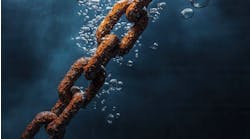The longest installation of a 7-in. production liner in an extended reach well in the Gulf of Mexico has been successfully completed. The liner was run to a total depth of 25,750 ft with a 22,200-ft horizontal displacement. The installation is a record for the US Gulf of Mexico.
The job involved Weatherford's Nodeco brand liner system, which has been used in the world record extended reach drilling (ERD) in southern England. The Nodeco-style tools are designed for rotation to move the liner to the desired setting depth and for rotation of the liner during cementing operations. The liner running tools used on this job consisted of the patented Floating Junk Bonnet (FJB), which eliminates debris from entering the liner top annulus and the field proven "R" running tool with retrievable cementing packoff.
The liner, with a PHS liner hanger and integral TSP liner top packer, was rotated and circulated from the 95/8-in. shoe at 19,500-25,750 ft. Total time reaming and circulating to get the liner on depth was about five days. Surface rotating torque reached the 35,000 ft-lb range, while rotating the liner to the setting depth. The Nodeco "R" running tool was released, and the PHS liner hanger was set at the design pressure of 3,200 psi. The ball seat sheared as planned, the TSP liner packer was set and tested plus the float equipment performed as designed.
Tool continuously samples, monitors formation fluids
Typically, the primary focus when using wireline-conveyed formation testers is to improve the quality of reservoir fluid samples. Through its digital control feedback system, Halliburton says its reservoir description tool (RDT) continuously samples and monitors formation fluids, enabling the wireline formation testing system to provide operators with accurate and extensive reservoir information.
The tool is said to make instantaneous changes in pumpout flow rates to maintain a prescribed rate, significantly improving formation fluid sampling and pressure testing. The tool also combines a pumping system motor with a hydraulic system that allows it to pump invaded fluids and formation fluids 50% faster. A company engineer said that by monitoring fluid and formation properties in real time, the optimum point to obtain a good sample quality can be determined, especially where zones are tested over a wide range of overbalance pressures in a single trip.
The RDT also is claimed to provide extended pressure range sampling through the use of two flow control pumpout sections. With this feature, the tool reportedly can obtain samples that are not possible with current generation tools. The tool also has the ability to monitor up to five fluid and formation properties during testing that include resistivity, bubble point, compressibility, horizontal and vertical permeability, and anisotropy.
Simultaneously deployed, closely spaced dual probes were also engineered to increase reliability through redundancy, and to allow for advanced pressure-testing techniques. For example, formation anisotropy (kv/kh) can be determined through interference testing between the two probes, while additional formation diffusive properties can be calculated using new pressure-pulsing techniques between each probe.
The tool's zero shock pressure-volume-temperature (PVT) sampling method is said to eliminate pressure transients during pumping and sampling, as well as perform closed-chamber PVT testing for the bubble point of the sampled fluid. The tester can be combined with existing open-hole logging tools, and tool sections are interchangeable, which permit a complete wireline tool string to be configured to meet particular open-hole formation evaluation and testing needs in a single trip into the well, saving rig-time and costs.
One-trip completion method
Recently, a subsea well on the North Sea's Fife Field had a horizontal open-hole completion performed and is now producing at 10,000 b/d of oil. The field is operated by Amerada Hess. Additionally, the completion set a world record with the Baker Oil Tools One-Trip selective cement inflation of nine payzone external casing packers (ECPs).
The completion was carried out in a 2,200-ft horizontal section that required isolation of several zones of high permeability to protect against potential water production. To complete this subsea well using a conventional cemented and perforated liner would have required 8-10 coiled tubing perforating runs, creating a significant expense and increasing the time and cost of performing the completion operation. The alternate, one-trip completion method called for running nine payzone ECPs, with hydraulic mechanical-hydraulic insulation tool (HM-HIT) profiles separated by CM Sliding Sleeves, to provide communication and isolation of the zones as required.
Nine ECPs were installed in the well: the lower seven to provide future zonal isolation, and the upper two to provide isolation between the chalk and the producing formation. The ECPs were run in conjunction with a 51/2-in. blank liner string with a Uniflex Liner Hanger Packer System to hang off and isolate the liner string inside the 95/8-in. casing.
The sliding sleeves at the top and bottom of the liner string were run in the open position. The bottom-sliding sleeve would allow the liner to be circulated into position in the horizontal section while the top-sliding sleeve would be used to relieve pressure in the annulus when the ECPs were inflated. Both sleeves were to be shifted to the closed position as the running string was pulled to the surface. The remaining sliding sleeves in the completion were run in the closed position.
Using the HM-HIT Tool, all nine ECPs were inflated in one trip. The CM Sliding Sleeves were opened successfully after the upper completion was run and the well circulated with seawater. Estimated production for the well was 8,000 b/d of oil. Actual production to date has averaged 10,000 b/d.
Reducing operating time and associated cost
Completion Isolation Valves (CIVs), acting as combined fluid-loss control and suspension barrier systems, can be used in sand screen and slotted liner completions. Overall production recovery can be increased by approximately 20% by preventing fluid losses that can cause reservoir damage. The valves can also ease the need for deployment of long tool strings and the perforating of extended intervals by reducing operating time and associated cost.
A contract to supply and install a range of completion system products, including CIVs, was awarded to Weatherford International by Shengli Petroleum Administration Bureau's Ocean Petroleum Development Company. The CIVs are being installed in 21 wells throughout the Bohai Bay, Shandong Province, China within the next two years. The flow-control systems are expected to save the operator approximately $12 million due to increased productivity and reduced fluid loss. Additional completion systems products to be included are wireline nipples, lock mandrels, sliding sleeves, expansion joints, annulus casing packers, chemical injection valves, and liner hangers.
Controlling unwanted water production
A new polymer system, H2Zero by Halliburton, is providing capabilities for controlling unwanted water production. It has reduced the amount of unwanted water produced from an oil well, by 98%, for Shell UK Exploration and Production. The treatment, with 403 ft of perforations, is the longest horizontal, subsea, water shut-off treatment completed to date. Shell UK Exploration and Production is operating in the UK sector of the North Sea on behalf of Shell and Esso.
Since the introduction of the H2Zero technology in 1998, it has recorded a 98 percent success rate utilizing the treatments. The application of this system has proven that, through better reservoir understanding, and enhanced chemistry, as well as quality planning and operations, the potential to achieve a 100 percent success rate exists.


